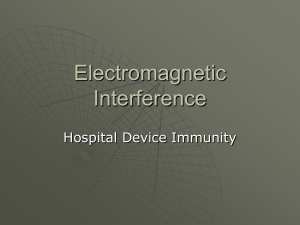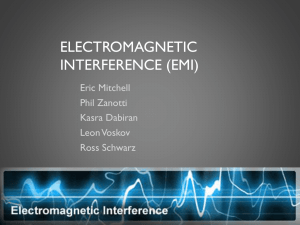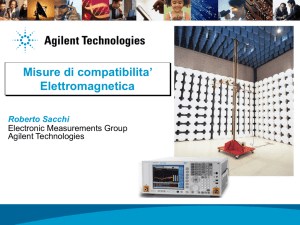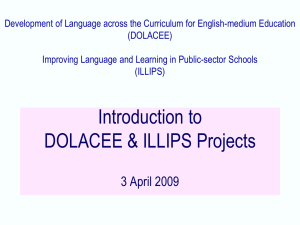electromagnetic compatibility management of wireless transceivers
advertisement
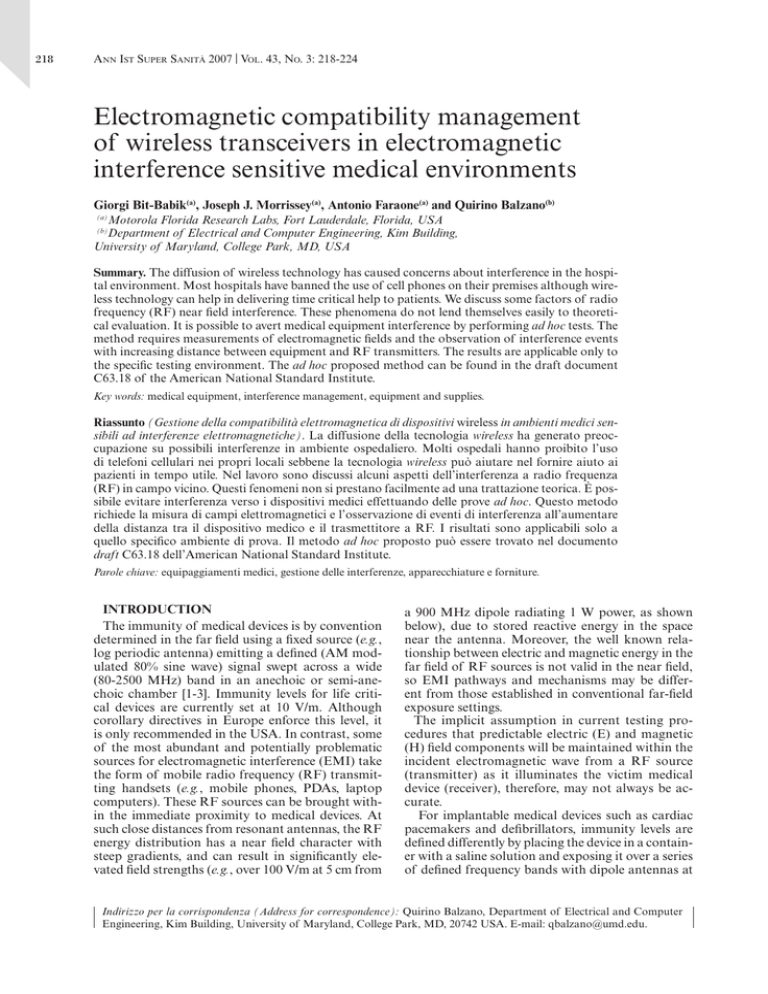
research from animal testing to clinical experience 218 Ann Ist Super Sanità 2007 | Vol. 43, No. 3: 218-224 Electromagnetic compatibility management of wireless transceivers in electromagnetic interference sensitive medical environments Giorgi Bit-Babik(a), Joseph J. Morrissey(a), Antonio Faraone(a) and Quirino Balzano(b) Motorola Florida Research Labs, Fort Lauderdale, Florida, USA Department of Electrical and Computer Engineering, Kim Building, University of Maryland, College Park, MD, USA (a) (b) Summary. The diffusion of wireless technology has caused concerns about interference in the hospital environment. Most hospitals have banned the use of cell phones on their premises although wireless technology can help in delivering time critical help to patients. We discuss some factors of radio frequency (RF) near field interference. These phenomena do not lend themselves easily to theoretical evaluation. It is possible to avert medical equipment interference by performing ad hoc tests. The method requires measurements of electromagnetic fields and the observation of interference events with increasing distance between equipment and RF transmitters. The results are applicable only to the specific testing environment. The ad hoc proposed method can be found in the draft document C63.18 of the American National Standard Institute. Key words: medical equipment, interference management, equipment and supplies. Riassunto (Gestione della compatibilità elettromagnetica di dispositivi wireless in ambienti medici sensibili ad interferenze elettromagnetiche). La diffusione della tecnologia wireless ha generato preoccupazione su possibili interferenze in ambiente ospedaliero. Molti ospedali hanno proibito l’uso di telefoni cellulari nei propri locali sebbene la tecnologia wireless può aiutare nel fornire aiuto ai pazienti in tempo utile. Nel lavoro sono discussi alcuni aspetti dell’interferenza a radio frequenza (RF) in campo vicino. Questi fenomeni non si prestano facilmente ad una trattazione teorica. È possibile evitare interferenza verso i dispositivi medici effettuando delle prove ad hoc. Questo metodo richiede la misura di campi elettromagnetici e l’osservazione di eventi di interferenza all’aumentare della distanza tra il dispositivo medico e il trasmettitore a RF. I risultati sono applicabili solo a quello specifico ambiente di prova. Il metodo ad hoc proposto può essere trovato nel documento draft C63.18 dell’American National Standard Institute. Parole chiave: equipaggiamenti medici, gestione delle interferenze, apparecchiature e forniture. INTRODUCTION The immunity of medical devices is by convention determined in the far field using a fixed source (e.g., log periodic antenna) emitting a defined (AM modulated 80% sine wave) signal swept across a wide (80-2500 MHz) band in an anechoic or semi-anechoic chamber [1-3]. Immunity levels for life critical devices are currently set at 10 V/m. Although corollary directives in Europe enforce this level, it is only recommended in the USA. In contrast, some of the most abundant and potentially problematic sources for electromagnetic interference (EMI) take the form of mobile radio frequency (RF) transmitting handsets (e.g., mobile phones, PDAs, laptop computers). These RF sources can be brought within the immediate proximity to medical devices. At such close distances from resonant antennas, the RF energy distribution has a near field character with steep gradients, and can result in significantly elevated field strengths (e.g., over 100 V/m at 5 cm from a 900 MHz dipole radiating 1 W power, as shown below), due to stored reactive energy in the space near the antenna. Moreover, the well known relationship between electric and magnetic energy in the far field of RF sources is not valid in the near field, so EMI pathways and mechanisms may be different from those established in conventional far-field exposure settings. The implicit assumption in current testing procedures that predictable electric (E) and magnetic (H) field components will be maintained within the incident electromagnetic wave from a RF source (transmitter) as it illuminates the victim medical device (receiver), therefore, may not always be accurate. For implantable medical devices such as cardiac pacemakers and defibrillators, immunity levels are defined differently by placing the device in a container with a saline solution and exposing it over a series of defined frequency bands with dipole antennas at Indirizzo per la corrispondenza (Address for correspondence): Quirino Balzano, Department of Electrical and Computer Engineering, Kim Building, University of Maryland, College Park, MD, 20742 USA. E-mail: qbalzano@umd.edu. EMC management in medical environments OMPLEXITY OF THE EMI PHENOMENA C IN MEDICAL DEVICES NEAR RF SOURCES Complexity of the near field structure of antennas EMI phenomena of import need the efficient transfer of the electromagnetic energy of the incident fields to a particular circuit within a medical monitor. This event is facilitated if the electric and magnetic energy content of the incident fields matches the dipole moment, electric and magnetic, of the affected circuit with all its metal, capacitive and inductive coupling connections. These extensions of a circuit enhance its ability to capture EM energy from incident waves essentially by turning it in an efficient receive antenna. In the far field of RF sources the EM waves carry equal amounts of electric and magnetic energy. Metal leads, straight wires and runners on PC boards normally couple efficiently with the electric energy (E-field) of an incoming wave, so EMI measurements are appropriately performed with a linearly polarized antenna for different positions of the devices under test. In the reactive and radiative near field of an antenna the balance between the electric and magnetic energy and the polarization of the electric and magnetic field vectors can change radically within a quarter wavelength of the operating frequency. For this reason, the pathways to EMI are much more complex and multifarious in the near field than in the far field of antennas. Circuits with a weak magnetic dipole moment can sustain EMI phenomena if the local magnetic field is very high (e.g., near a strong RF current); conversely a weak electric dipole moment of a circuit can be strongly excited by the intense E-fields near the tips of a helical antenna [13]. Figure 1 and Figure 2 show the electric 3.5 3 2.5 Volt/cm 2.5 cm away [4] from the surface of the solution. The most recent revisions of this test procedure include higher immunity requirements and addition of test frequencies corresponding to common licensed and unlicensed communication devices. These modifications largely arose from well-documented studies reporting that EMI could be caused by mobile phone transmitters [5, 6]. In these studies, modulated RF signals (e.g., GSM), close proximity, and older pacemaker models seemed to collectively contribute to vulnerability, although subsequent studies and surveys have indicated that significant EMI events in actual pacemakers are not common. Several global regulatory agencies including the US FDA [7], UK MHRA [8], Health Protection Branch of Health Canada [9], and Australian Department of Therapeutic Devices [10], have suggested separation distances between implantable cardiac devices and mobile phones as well as other measures to avoid interaction, but admit these are precautionary and not a result of a verified risk in practice. Several synergistic factors, including the proliferation of mobile RF communication and computing devices, the rapid diffusion of new electronic and wirelessly enabled medical devices, and the growing age of the population in need of healthcare monitoring increase the probability that mobile RF transmitters (sources) may be brought in close proximity to medical devices (victims). Anecdotal reports regarding medical device EMI from mobile phones initially caused concern and led to numerous bans of wireless communication devices from many hospitals during the 1990s. In recent years, however, increasing dependence upon mobile communication and computing within the medical community [11, 12] as well as a better understanding and qualification of EMI-related risks has led to the development of international standards outlining strategies for managed use of mobile phones and other RF transmitters in healthcare facilities (ISO Technical Report 21730; AAMI TIR n. 18). However, increased testing and evaluation of potential EMI effects can further improve management strategies. The process currently adopted in evaluating interference events in medical devices close to wireless communication equipment is empirical and has consisted of observing the fall off of interference with distance from the RF source. In this paper, we show that this approach is the most appropriate, as an analytical methodology is faced with an array of variables that make the mathematical modeling unrealistic. In addition to the complex array of leads, internal wires and circuits, and apertures associated with the medical device itself, other variables such as the placement in relationship with other medical instruments, the environment and potential reflecting/shielding structures, personnel monitoring activity of the medical devices, power level, signal modulation and position of the source transmitter all do affect greatly the potential for interference. = 1 cm 2 = 5 cm 1.5 1 0.5 0 0 1 2 3 4 5 6 7 8 Distance from feed point (cm) Fig. 1 | Modulus of the near electric field of a resonant dipole 15.8 cm long radiating 0.25 W at 900 MHz. Note the rapid drop of the field over only 4 cm distance. 219 Giorgi Bit-Babik, Joseph J. Morrissey, Antonio Faraone et al. 0.01 0.009 = 1 cm = 5 cm 0.008 0.007 0.006 A/cm 220 0.005 0.004 0.003 0.002 0.001 0 0 1 2 3 4 5 6 7 8 Distance from feed point (cm) Fig. 2 | Modulus of the near magnetic field of the resonant dipole of Figure 1. Note that near the center of the antenna the H-field decreases by the magnetostatic law of Biot-Savart. Near the tip there is minimal attenuation vs distance. and magnetic field intensities at two distances (ρ = 1 cm and ρ = 5 cm) from the axis of one branch of a resonant cylindrical dipole at 900 MHz (wavelength λ = 33.33 cm) radiating 0.25 W. The dipole is 15.8 cm long and has a radius of 0.1 cm. Twenty harmonics have been used to compute the current on the antenna [14], so the field amplitudes are quite accurate. By denoting η = 377Ω the impedance of free space, one can see that for ρ = 1 cm the EM energy is predominantly magnetic near the center of the radiator (H>>E/η) and predominantly electric near its tips (E/η>>H). Very different EMI mechanisms are triggered in these two regions of the near field. The authors in [5] reported that some cardiac pacemakers were suffering EMI events near the feed point of antennas, but not near the tips of a dipole where the E-field is the strongest. It is worth noticing that the field intensity distribution changes radically in only 4 cm (about 0.12λ). At 5 cm distance from the axis of the antenna the intensity of the electric and the magnetic field is approximately uniform along a path parallel to the axis of the radiating element. This distance is approximately equal to λ/2π and conventionally marks the end of the reactive near field of the antenna. Complexity of the EMI susceptibility of sensitive medical monitoring devices In general, medical monitoring devices employ high gain electronic amplifiers to detect and measure low voltage signals. As discussed above, the electromagnetic susceptibility of these circuits depends on the geometrical, physical and circuital factors of the monitoring apparatus. We shall describe these factors as the incident electromagnetic waves encounter them. First, the size, shape, material, grounding of the metal enclosure and the presence of slots are parameters of importance in determining the susceptibility of the device. The power chord length and its shape (coiled or extended) also can cause EMI phenomena at certain frequencies by acting as an RF antenna and injecting RF currents into the electronics within the metal enclosure, particularly common mode currents featuring in-phase amplitudes on both power chord conductors. Metal leads attached to a patient or simply dangling from a monitor can become effective EMI antennas at certain RF frequencies depending on their length and terminations. Even metal studs or metal walls can reflect or couple RF EM fields into a medical device; e.g., if a monitor is at the proper distance from two joined metal walls, these can act as a corner reflector focusing EM energy on the device, which becomes a receive antenna. Metal enclosures with air venting slits can be EM shields at certain low frequencies, but can become resonant cavities well coupled to the near fields of an antenna at higher frequency bands. A parallelepiped enclosure example can vividly demonstrate this phenomenon. Figure 3 shows a metal enclosure with a slot on one side. The enclosure could contain the electronics of a medium size medical monitor; the slot is for cooling and ventilation. Figure 4 gives the amplitude of the E-field inside the enclosure at 5 cm from the slot vs frequency. A plane wave polarized in the z direction (Figure 3) is incident on the slit side of the box. One can see the selectivity with which the E-fields penetrate into the enclosure. At most frequencies, the enclosure acts as a good electromagnetic shield, but in selected narrow bands the shielding is lost. The computations of Figure 4 have been performed using the software package CST MICROWAVE STUDIO® [15]. y z x Fig. 3 | Metal box representing the enclosure of a medium-size medical instrument. The metal box size is 190×300×90 mm3. The box has a slit representing an air cooling intake. Slot length: 140 mm, slot width: 2 mm. EMC management in medical environments �� ������������� �� �� �� � ��� ��� ��� ��� ��� � ��� ��� ��� ��� ��������������� ��� ��� ��� The loss of shielding function by the same metal enclosure is shown more clearly in Figure 5, which plots the computed E-fields from a resonant dipole antenna radiating 1W placed at 5 cm distance from the center of the slot. The computations were performed using the FEKO software package [16]. There are two radically different coupling situations between a dipole antenna and the metal enclosure with a single slot. The solid line in Figure 5 plots the Ez (see Figure 3) field component from the antenna along a line from the center of the dipole to the center of the slot; the axis of the antenna is perpendicular to the slot. For reference, the same component of the antenna in free space is also shown in Figure 5. While the free space field intensity decays with ��� ��� � Fig. 4 | Electric field intensity vs frequency at 5 cm inside the metal enclosure of Figure 3. The metal enclosure has selective electromagnetic energy absorption vs frequency. Interference phenomena inside the box depend strongly on the wavelength of the external incident fields. the inverse distance law (a straight line in log scale) past the first 5 cm of the reactive near field, the Ez inside the box does not. There is a substantial field enhancement in the immediate vicinity of the slot, followed by a region of near constant Ez. The field decreases past the position x = -205 mm and goes to zero at the back wall of the enclosure (x = -240 mm). The important point depicted by the solid line in Figure 5 is that there is a substantial amount of RF energy in a large area of the cavity in the plane of the slot. The computed Ey (see Figure 3) component values with the same antenna parallel to the slot are shown as a broken line in Figure 5. The results show that the energy coupled inside the enclosure is minimal and hangs 80 70 Dipole perpendicular to the slot 60 Electric field (dBV/m) 50 40 30 20 Dipole in free space 10 0 -10 -20 Position of the slot Dipole parallel to the slot -30 -40 -210 -185 -180 -165 -150 -135 -120 -105 -90 Position x (mm) -75 -60 -45 -30 -15 0 Fig. 5 | Electric field attenuation inside the box of Figure 3 for two polarizations of an external resonant dipole. Note the minimal electromagnetic energy penetration with the antenna is parallel to the slot. The metal box offers no shielding (attenuation lower than in free space) with the antenna orthogonal to the slot. 221 222 Giorgi Bit-Babik, Joseph J. Morrissey, Antonio Faraone et al. around the place of entry, i.e. the shield is preventing the penetration of the RF energy inside the medical monitor. The ratio of the field energies coupled into the metal enclosure by the slot for the two orientations of the same antenna is about 80 dB. The situation of the solid line in Figure 5 must be conceived along with the presence of an electronic device with substantial dipole moments (electric, magnetic or both) located at or near the peak of the EM field intensity. Such device could be exposed to RF electric and magnetic fields far above (e.g., 40-80 dB) design specifications. A nonlinear component could be saturated and become non functional. Inside a medical monitor there are printed circuit boards (PCB), which are grounded and there may be inter or intra board electrical connections (e.g., signal traces or ribbon cables). The interconnect paths can act as high frequency antennas; grounding contacts designed for the low frequency operation (few KHz) of medical devices may fail to maintain a constant potential at higher frequencies, if RF energy leaks or is conducted inside the metal enclosure. The PCB metal runners (traces) are poor or good RF antennas depending on their geometry and proximity to the ground layer. Traces can become good antennas at certain frequencies also depending on the components they connect. Capacitors and inductors can tune a particular runner to be an efficient receive antenna over a certain frequency band. The layout of traces, capacitors and inductors can cause mutual coupling between different parts of a board or between boards, thus increasing the chance of creating a resonant structure at some high frequency band. If the RF energy penetrates the shield, it can well be sucked in a particularly sensitive electronic circuit whose performance is severely impaired by saturation, rectification or other nonlinear events. Even with the most sophisticated PC board layout and electromagnetic analysis tools available today [16, 17], engineers are not able yet to simulate the complex electromagnetic environment of thickly populated boards inside a resonant metallic enclosure coupled through air venting slots to the near field of an antenna. A PRACTICAL METHOD FOR cHARACTERIZING EMI IN MEDICAL DEVICES FROM WIRELESS TRANSMITTERS From the previous discussion it is clear that EMI phenomena in the near field of wireless transmitters are very difficult to predict or simulate by analysis. Only well-tested and reliable experimental procedures can establish, with some confidence, the minimum safe distance between a RF transmitter and a medical device in the hospital environment. By “safe distance” is meant the distance where there is no detectable EMI phenomenon that impairs the function of the medical apparatus. Ad hoc proce- dures are well-accepted methods for system-level EMI testing [18]. The ANSI draft document C63.18 [19] has captured and systematized the procedures used by several engineers and hospital personnel [20-23] in trying to establish a minimum safe distance between medical devices and RF transmitters. The draft document gives detailed suggestions on the procedures for each phase of an EMI test program. It starts with a section on preparation for ad hoc testing which includes recommendations on the selection of the medical devices to be tested, of the RF transmitters to be used as test sources, and of the test areas. This section also gives the minimum specifications for the RF field strength meter to be used during the tests. The next section offers careful considerations on transmitter use during the test and specifies how to determine the recommended minimum test distance for each transmitter. If testing is performed closer than the recommended minimum test distance, damage to the medical device under test could result. A table relates the minimum test distance with the RF transmitter output power. Devices with RF power higher than 8 W should not be tested in a hospital environment. The recommended operation of RF transmitters during ad hoc tests is presented in detail. These include: - hand-held transceivers; - cellular and PCS telephones; - table-top RF transmitters; - medical telemetry transmitters; - wireless information technology transmitters (e.g., wireless LAN). The test method section suggests the procedures for the evaluation of the performance of a medical device under test, which consists of increasing the distance between the transmitter and the medical device, starting from a pre-established minimum distance with the transmitter set at maximum power output. During the ad hoc RF immunity test, the responses of the medical device must be recorded as a function of the RF transmitter distance, orientation, and frequency. In noting the response of the medical device to the RF transmitter, it is also important to distinguish between effects that would and effects that would not impact patient or operator safety or the diagnosis, monitoring, and/or treatment of patients. If the transmitter does not affect the medical device, or if there are effects but they are determined to be acceptable, then the minimum recommended separation distance between that transmitter and that medical device is the minimum recommended test distance. The compilation of the measured data and observations constitute the test results. These should be used to determine a minimum separation distance between each tested transmitter and medical device (including cables, sensors, and electrical accessories). When assessing the test results, it is essential EMC management in medical environments that they be interpreted bearing in mind the caveats and limitations of an ad hoc test procedure. The test results apply only to that specific, individual medical device. Other units of the same model may behave differently. The test results also apply only to the frequency, modulation, and field strength characteristics of the RF transmitter used. The medical device may be either susceptible or immune to other frequencies, modulations, and/or field strengths. In addition, the tests are affected by the structure of the facility, in which the tests are performed, as well as by furniture and nearby objects. Results may be different in another location. Multiple reflections of RF fields in the actual use location can sum in such a way that interference can occur at distances greater than the minimum separation distance determined from the ad hoc procedure. The healthcare organization should determine whether the effect or performance degradations observed during the tests are acceptable or not. The advice of clinical staff is helpful in determining the clinical acceptability of any observed performance degradations. Results of the test should be considered in the development of policies and procedures for mitigation of EMI with respect to each medical device and RF transmitter used in the test program. SHORT SUMMARY OF THE RESULTS TO DATE Minimum safe distance data and detected EMI phenomena are presented for some common medical devices. The information has been collected by visiting four US hospitals (St. Luke Mayo Clinic, Sunnybrook NY, Stanford CA and University of Chicago, IL) and EMI testing the analog and digital signals of the US wireless networks, following the procedure outlined in the previous section. In Table 1 we report only the extreme cases of EMI for the various devices tested. In general, but not always, signals with high pulse amplitude and low (less than 100 Hz) repetition rate caused the extreme cases of interference in terms of disruption vs distance. In addition, if a device shows high EMI susceptibility for one type of RF signal, it is also most likely susceptible to others. Good electromagnetic compatibility (EMC) design of a product protects the device from the interference of any RF signal, while poor EMC design leaves it open to interference from a wide variety of modulated electromagnetic fields. From the data presented above, it is clear that keeping cell phones and other low power transceivers (less than 0.5 W) at 0.75 meter or greater distance from medical equipment, there is a small probability of EMI events that trigger the malfunction of the devices. One should keep in mind that the data were collected with the transmitters set at maximum operating power (0.25-0.5 W), and several options exist to provide infrastructure to a hospital facility to keep handheld units transmitting at minimal output power (3-6 mW). There are exceptions to the simple rule given above, so compatibility tests should be performed for the specific equipment of a hospital. Finally, if a device is found to be particularly susceptible to EMI, it can be clearly marked for minimum safe distance and properly isolated or just replaced. This decision can be made by the hospital administration in concert with the medical personnel. Table 1 | Detected extreme cases of electromagnetic interference (EMI) Medical device Detected EMI effect / distance Blood warmers No effect at 0.25 m Gas analyzers Some speaker distortion at 0.25 m Ventilators/monitors Shut down at 5 cm, substantial change of respiratory volume at 1 m Infusion pumps Stopped pumping at 0.75 m ECG readers Unacceptable noise in ECG waves at 0.5 m Defibrillators Unacceptable noise in ECG waves at 1.25 m Multipurpose ECG Monitors/ Pulse oxymeter/ Arterial pressure Unacceptable ECG wave distortion at 0.25 m Infant incubators Temperature alarm at 0.25 m EEG Unacceptable noise on waves at 0.25 m from the monitor. No noise at 5 cm from patient leads Dialysis machines Screen wobble, decrease in arterial and venous pressure readings, pump slowed at 0.5 m Sonogram machines No effects at 5 cm Mobile ECG units Disrupted transmission at 10 cm Pulse oxymeters Unacceptable audio distortion at 0.25 m 223 224 Giorgi Bit-Babik, Joseph J. Morrissey, Antonio Faraone et al. CONCLUSIONS This paper has attempted to explore the mechanisms of EMI phenomena in medical devices exposed to the near field of wireless transmitters. The complexity of these events has inspired experimental ad hoc procedures, rather than analytical approaches to resolve EMI issues for medical equipment in the hospital setting. All the data collected so far point out that with careful planning, coupled with an ad hoc evaluation of the potential EMI phenomena in the hospital, it is possible to resolve the issues of compatibility between medical equipment and low power RF portable transceivers. In the future, if a large enough set of measurements is made on the same medical devices in various hospital environments it will be possible to give a statistical range to the limits of variability of the measurements obtained using the ad hoc method described in this paper. Acknowledgement The authors wish to thank Felice Vanin for the help in the computations of the near fields of the cylindrical dipole antenna. Submitted on invitation. Accepted on 24 January 2007. References 1. International Electrotechnical Commission. IEC 60601-1-2. Medical electrical equipment. Part 1: General requirements for safety-2. Collateral standard: Electromagnetic compatibility. Requirements and tests. Geneva: IEC; 2001. 2. International Electrotechnical Commission. IEC 61000-4-3. Electromagnetic compatibility (EMC). Part 4: Testing and measurement tech­niques. Section 3: Radiated, radio-frequency, electromagnetic field immunity test. Geneva: IEC; 2002. 3. MDS-201-0004: 1979. Electromagnetic compatibility standard for medical devices (FDA voluntary guide­line). 4.ANSI/AAMI PC69. American active implantable medical devices – Electromagnetic compatibility – EMC test protocols for implantable cardiac pacemaker and implantable cardioverter defibrillators. Washington, DC: National Standard Institute / Association for the Advancement of Medical Instrumentation; 2000. 5. Barbaro V, Bartolini P, Donato A, Militello C. Electromagnetic interference of analog cellular telephones with pacemakers. Pacing Clin Electrophysiol 1996;19:1410-8. 6. Barbaro V, Bartolini P, Donato A, Militello C, Altamura G, Ammirati F, Santini M. Do European GSM mobile cellular phones pose a potential risk to pacemaker patients? Pacing Clin Electrophysiol 1995;18:1218-24. 7. Food and Drug Administration. Update on cellular phone interference with cardiac pacemakers. Available from: http:// www.fda.gov/cdrh/emc/pace.html; last visited 19/02/2007. 8. Medicines and Healthcare Products Regulatory Agency (MHRA). PTN No 61 - Possible interference or interaction between cellular mobile telephones (especially digital GSM) and implantable pacemakers and defibrillators. UK: MHRC; 1996. 9. Digital cellular phone interference with cardiac pacemakers. (Alert Letter n. 108). Ottawa, Canada: Health Canada, November 6, 1995. 10.Australian Dept Therapeutic Goods. Australian Therapeutic Device Bulletin 1997;34:1-12. 11. Soto RG, Chu LF, Goldman JM, Rampil IJ and Ruskin KJ. Communication in critical care environments: mobile phones improve patient care. Anesth Analg 2006;102:535-41. 12. Morrissey JJ. Mobile phones in the hospital: improved mobile communication and mitigation of EMI concerns can lead to an overall benefit to healthcare. Health Physics 2004;87:82-8. 13. Balzano Q, Garay O and Siwiak K. The near field of omnidirectional helical antennas. IEEE Trans Vehic Technol 1982;VT-31:173-84. 14. Balzano Q, Garay O, Siwiak K. The near field of dipole antennas. Part 1: Theory. IEEE Trans Vehic Technol 1981;VT30:161-74. 15.Computer Simulation Technology (CST). CST MICROWAVE STUDIO®, User Manual 2006. Darmstadt, Germany: CST GmbH; 2005. 16. FEKO Development Center EM Software & Systems-SA (Pty) Ltd. FEKO software package. Stellenbosch, South Africa. 17.Ansoft Corporation. HFSS. Los Angeles: Ansoft Corporation; 2006. 18. Pignari SA. Statistics and EMC. URSI Radio Science Bulletin 2006;316:13-26. 19.ANSI. Standard C63.18. Recommended practice for an onsite, ad hoc test method for estimating radiated electromagnetic immunity of medical devices to specific radio- frequency transmitters. Washington, DC: American National Standard Institute; 1997. 20. Morrissey JJ, Swicord M, Balzano Q. Characterization of electromagnetic interference in medical devices in the hospital due to cell phones. Health Physics 2002;82:45-51. 21.Turcott J, Witters D. A practical technique for assessing EMI in the clinical setting ad hoc. Testing Biomed Instrum Technol 1998;32:241-52. 22. Shaw CI, Kacmarek RM, Hampton RL, Riggi V, Masry AE et al. Cellular phone interference with the operation of mechanical ventilators. Crit Care Med 2004;32:1074-5. 23.Tri JL, Severson RP, Firl AR, Hayes DL, Abenstein JP. Cellular telephone interference with medical equipment. Mayo Clinic Proceedings 2005;80:1286-90.

